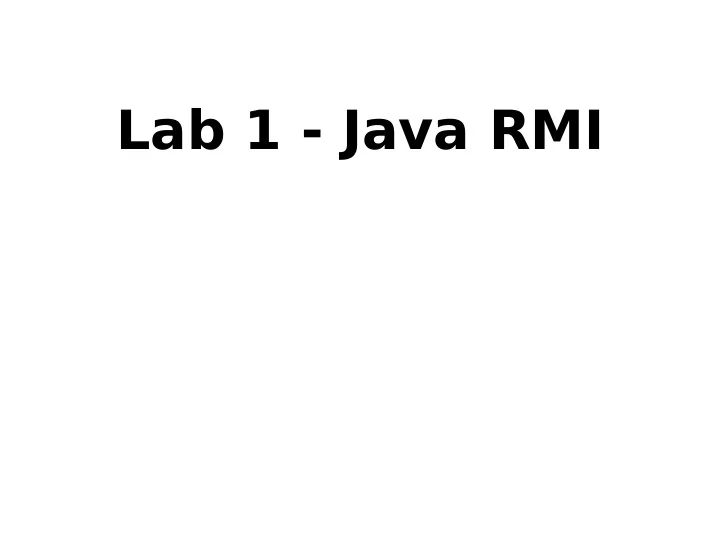

Lab 1 - Java RMI
RMI Remote Method Invocation Object-oriented RPC (Remote Procedure Call) Allows calling methods of a remote object (over a network) through standard invocation of interface methods Guide https://docs.oracle.com/javase/8/docs/technotes/guides/rmi/index.html API https://docs.oracle.com/javase/8/docs/api/java/rmi/package- summary.html Spec https://docs.oracle.com/javase/8/docs/platform/rmi/spec/rmiTOC.html
Hello World Shows how use RMI to: run a server which creates an object that accepts remote calls registers this object under a name in a registry run a client which retrieves a proxy to a remote object from a registry calls methods of the remote object on the server passes values to and from the remote object Download example and assignment files https://d3s.mff.cuni.cz/files/teaching/nswi080/as1.zip
Java Sources Example.java remote interface ExampleImpl.java implementation of remote interface instances are remote objects ExampleServer.java creates a remote object registers the object in a registry accepts calls to the remote object ExampleClient.java retrieves a proxy to the remote object calls a method of a remote object
Scripts make run by bash make compile java files using javac generating stub classes using rmic is not done anymore, they are generated dynamically run-registry starts a rmiregistry process run "in the background" Port in use? – use different port number ($> 1024$) Edit path in calls to [re]bind() and lookup() localhost becomes localhost:1234 for simplicity, all scripts use the same classpath we avoid setting up codebase, permissions, ...
Scripts run-server starts the server kill by Ctrl+C java.rmi.server.hostname = what address will client use to call methods on the server (address stored in proxy objects) run-client runs the client
Task 1 - Java RMI
Distance between Graph Nodes public interface Searcher { public int getDistance(Node from, Node to); } public interface Node { Set<Node> getNeighbors(); void addNeighbor(Node neighbor); } Node[] graph;
1 - Local implementation Interfaces Node and Searcher Breadth-first graph search algorithm Local implementation provided Executable Main class generates a random graph measures speed of random queries
Task Extend the provided implementation to search the graph remotely Compare speed of various configurations
2 - Remote Searcher Extend the Searcher interface (see Example ) Interface java.rmi.Remote Exception of type java.rmi.RemoteException Remotely accessible object (see ExampleImpl ) Must be exported – 2 possible ways Derive from java.rmi.server.UnicastRemoteObject Export ensured by parent constructor Call UnicastRemoteObject.exportObject(obj) manually Does not handle semantics of hashCode() , equals() , toString() –- not a problem with Searcher (just one instance)
2 - Remote Node Objects Extend interface Node with RMI (like Searcher ) Class inherits from UnicastRemoteObject and implements Node T o allow for hashCode() , equals() , toString() Copy/paste + edit is enough We want the local Node s in the previous part still behave locally
3 - Remote Node Objects (cont.) How to create and return instances for client requests? Implement NodeFactory with a method createNode() Similar to remote Searcher – an interface with RMI, an implementing class, create an instance and call Naming.bind() inside the existing server Do not create a separate server for nodes, we want just one for the next variant Client gets the reference using lookup() , then creates the remote Node objects together with the local graph How does the local Searcher access the remote Node s? What exactly does the NodeFactory return to the client?
4 - Remote Searcher and Nodes Everything is ready, just add this variant to searchBenchmark() and compare the speed How does the Searcher on server access the Node objects on (the same) server
Impact of the Network So far, client and server were running on the same machine Overhead of RMI communication, but no network latency Run on more machines Server on the machine next to you, client on yours Change the paths in [re]bind() and lookup() Remote machine name instead of localhost Modify main to use args[0] Run rmiregistry and Server in an SSH session on the remote machine Run the client locally Beware of CLASSPATH
Passing by Value vs. Reference Previous tasks show “extreme” cases How about combining both approaches? Idea: “batch” transfer bigger parts of the graph getTransitiveNeighbors(int distance) Returns all neighbors up to some distance Use the getDistanceTransitive method of the Searcher interface In each step, requests neighbors up to the specified distance Try different values for the distance parameter Compare measured times with previous variants
Implementation Notes Extend the single project, do not create 4 separate ones. Interface hides different implementations Even Remote interface can be used locally Just catch exceptions that would never occur E.g. remote graph is just another array Node[] Easy to have the same (logically) local and remote one Similarly with Searcher Measure everything in one run to ease comparison Just add measuring and a column to results in searchBenchmark()
Submission Working implementation Documentation Answer all the questions from the assignment Describe measurement results By e-mail (deadline is on the web) Make sure it works in the lab downstairs The submission shall be easy to start Use the provided implementation No need for Maven or Ant script Do not add packages etc. Updated versions of the run-server scripts
Recommend
More recommend